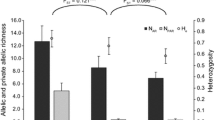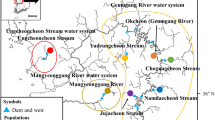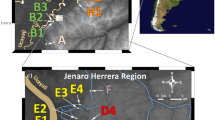Abstract
Pseudorasbora pumila pumila was collected to investigate its genetic relationships from 11 localities in Hokkaido and eastern Honshu of Japan with Pseudorasbora parva from 6 localities in Hokkaido, eastern Honshu, and Polovynka River (a tributary of the Amur River in eastern Russia) in 1996–1998. In Hokkaido and Akita prefectures (Honshu), three P. pumila pumila populations were distributed with P. parva sympatrically. Samples of P. pumila pumila and P. parva were analyzed based on 27 allozyme loci. Genetic differentiation between P. pumila pumila and P. parva (D = 0.522–0.622, average 0.601) was almost equal to or greater than that between other congeneric fish species previously reported. In the three sympatric populations of two species, which had arisen from artificial transplantation of the latter into localities of the former, the individual frequency composition of genetic types (P. pumila pumila, P. parva, F1 hybrid, and later filial generation hybrid) were significantly different from each other. Differing from the previous studies, F1 hybrids were fertile and coexisting populations of the two species included the F1 hybrid and the later filial generation hybrid. These results suggest that genetic population dynamics of sympatric populations of the two species would be influenced not only by hybridization but also by ecological and environmental factors. Alternatively, the existence of populations that possessed both the alleles specific to P. pumila pumila and those specific to P. parva may indicate that introgressive hybridization, instead of species displacement, has occurred between the two species under a certain condition.
Similar content being viewed by others
References
PB Aebersold GA Winas DJ Teel GB Milner FM Utter (1987) ArticleTitleManual for starch gel electrophoresis: a method for the detection of genetic variation. NOAA (Natl Ocean Atmos Adm) Tech Rep NMFS (Natl Mar Fish Serv) 61 1–19
JC Avise NC Saunders (1984) ArticleTitleHybridization and introgression among species of sunfish (Lepomis): analysis by mitochondorial DNA and allozyme markers Genetics 108 237–255 Occurrence Handle6090268
H Aoyagi (1957) General notes on the freshwater fishes of Japanese Archipelago (in Japanese) Daisyukan Tokyo
M Beger GP Jones PL Munday (2003) ArticleTitleConservation of coral reef biodiversity: a comparison of reserve selection procedures for corals and fishes Conserv Biol 17 53–62
LB Crespin PJD Lebreton (2001) ArticleTitleSpatially varying natural selection in a fish hybrid zone J Fish Biol 61 IssueID3 696–711 Occurrence Handle10.1111/j.1095-8649.2002.tb00905.x
J Clayton DN Tretiak (1972) ArticleTitleAmine-citrate buffer for pH control in starch gel electrophoresis J Fish Res Board Can 29 1169–1172
DB Donald DJ Alger (1993) ArticleTitleGeographic distribution, species displacement, and niche overlap for lake trout and bull trout in mountain lakes Can J Zool 71 238–247
TP Good JC Ellis CA Annett R Pierotti (2000) ArticleTitleBounded hybrid superiority in an avian hybrid zone: effect of mate, diet, and habitat choice Evolution 54 1774–1783 Occurrence Handle11108604
A Goto S Nakano (1993) Distribution and ecology of freshwater fishes in Hokkaido S Higashi A Osawa K Kanagawa (Eds) Biodiversity and ecology in the northernmost Japan Hokkaido University Press Sapporo 113–126
T Hikita T Terao (1959) ArticleTitleNotes on a new locality and morphological observations of cyprinoid fish, Pseudorasbora pumila pumila Miyadi, in eastern Hokkaido (in Japanese) Hokkaido Fish Hatch Res 14 67–71
Hosoya K (1979) Recently endangered Pseudorasbora pumila pumila and P. pumila subsp. (in Japanese). Tansuigyo (5):117
K Hosoya (1993) Cyprinidae and Cobitidae (in Japanese) T Nakabo (Eds) Fishes of Japan with pictorial keys to the species Tokai University Press Tokyo 212–235
Hosoya K, Maehata M (1994) Circumstances of endangered Janpanese freshwater fishes with note on the protection Hokkaido (in Japanese). Bull Natl Res Inst Aquac (23):17–25
Kasama M, Kobayashi H, Sugiyama H (1990) Hybridization experiment in Cyprinida (XIII). Cross between Pseudorasbora parva and P. pumila pumila (in Japanese). In: Ichthyological Society of Japan, advance abstracts for 23rd annual meetings, 31 March–1 April 1990, Tokyo
Kasama M, Kobayashi H, Sugiyama H (1991) Hybridization experiment between Pseudorasbora parva and P. pumila pumila (II) (in Japanese). In: Ichthyological Society of Japan, advance abstracts for 24th annual meetings, 31 March–1 April 1991, Tokyo
K Kawamura T Ueda R Arai Y Nagata K Saitoh H Ohtaka Y Kanoh (2001) ArticleTitleGenetic introgression by the rose bitterling, Rhodeus ocellatus ocellatus, into the Japanese rose bitterling, R. o. kurumeus (Teleostei: Cyprinidae) Zool Sci 18 1027–1039 Occurrence Handle10.2108/zsj.18.1027
M Konishi K Hosoya K Takata (2003) ArticleTitleNatural hybridization between endangered and introduced species of Pseudorasbora, with their genetic relationships and characteristics inferred from allozyme analyses J Fish Biol 63 213–231 Occurrence Handle10.1046/j.1095-8649.2003.00146.x
Matsubara H (1982) Artificial disturbance of distribution of Oncorhynchus masou and O. rhodurus (in Japanese). Special on freshwater fishes: Oncorhynchus masou et O. rhodurus, pp 87–91
BibInstitutionalEditorNameMinistry of the Environment (Eds) (2003) Threatened species of Japanese–red data book, 2nd edn, vol 4. Pisces. Brackish and fresh water fishes, Hokkaido (in Japanese) Japan Wildlife Research Center Tokyo
T Mukai (2001) ArticleTitleHybridization and introgression in the speciation process of fishes Hokkaido (in Japanese) Jpn J Ichthyol 48 1–18 Occurrence Handle10.1016/S0021-5155(00)00304-X
Y Nagata (1997) Rhodeus ocellatus kurumeus Y Nagata K Hosoya (Eds) Circumstances in endangered Japanese freshwater fishes and their protection (in Japanese) Midori-shobo Tokyo 76–85
M Nakamura (1969) Cyprinid fishes of Japan: studies on the life history of cyprinid fishes of Japan (in Japanese) Research Institute of Natural Resources Tokyo
M Nei (1972) ArticleTitleGenetic distance between populations Am Nat 106 283–292 Occurrence Handle10.1086/282771
MA Noor (1995) ArticleTitleSpeciation driven by natural selection in Drosophila Nature (Lond) 375 674–675 Occurrence Handle10.1038/375674a0
GJ Ridgway SW Sherburne RD Lewis (1970) ArticleTitlePolymorphism in the esterases of Atlantic herring Trans Am Fish Soc 99 147–151 Occurrence Handle10.1577/1548-8659(1970)99<147:PITEOA>2.0.CO;2
H Sakai (1987) Population genetics of hybridization in the genus Tribolodon, Cyprinidae N Mizuno A Goto (Eds) The freshwater fishes of Japan (in Japanese) Tokai University Press Tokyo 18–30
Sato K (1982) Natural hybridization of Salvelinus leuromaenis and Oncorhynchus masou (in Japanese). Special on freshwater fishes: Oncorhynchus masou et O. rhodurus, pp 74–77
JB Shaklee CS Tamaru RS Waples (1982) ArticleTitleSpeciation and evolution of marine fishes studied by electrophoretic analysis of protein Pac Sci 36 141–157
JB Shaklee FW Allendorf DC Morizot GS Whitt (1990) ArticleTitleGene nomenclature of protein coding loci in fish: proposed guidelines Trans Am Fish Soc 119 2–15 Occurrence Handle10.1577/1548-8659(1990)119<0002:GNFPLI>2.3.CO;2
CR Shaw R Prasad (1970) ArticleTitleStarch gel electrophoresis of enzymes, a compliation of recipes Biochem Genet 4 297–320 Occurrence Handle10.1007/BF00485780 Occurrence Handle4193186
PHA Sneath RR Sokal (1973) Numerical taxonomy Freeman San Francisco
DL Swofford RB Selander (1981) ArticleTitleBiosys-1: a FORTRAN program for the comprehensive analysis of electrophoretic data in population genetics and systematics J Hered 72 281–283
Takahashi K, Monma Y, Hosoya K, Takatori T, Kiso K (1995) Rediscovery and artificial reproduction of Pseudorasbora pumila pumila Miyadi from the type locality (in Japanese). Bull Miyagi Pref Freshw Fish Exp Stn (2):1–9
T Takami T Yoshihara Y Miyakoshi R Kuwahara (2002) ArticleTitleReplacement of white-spotted charr Salvelinus leucomaenis by brown trout Salmo trutta in a branch of the Chitose River, Hokkaido (in Japanese) Nippon Suisan Gakkaisi 68 24–28
Takeuchi M, Matsumiya T, Sawara Y, Ogawa T, Ohta T (1985) The freshwater fish fauna of Aomori Prefecture, Japan (in Japanese). Tansuigyo (11):117–133
D Tilman (1996) ArticleTitleBiodiversity: population versus ecosystem stability Ecology 77 350–363
D Tilman (1999) ArticleTitleThe ecological consequences of changes in biodiversity: a search for general principles Ecology 80 1455–1474
R Uchiyama (1987) ArticleTitleMorphology and ecology of Pseudorasbora pumila subsp. (in Japanese) Tansuigyo 13 74–84
JA Vucetich TA Maite (1998) ArticleTitleOn the interpretation and application of mean times to extinction Biodivers Conserv 7 1539–1547 Occurrence Handle10.1023/A:1008808617633
K Watanabe K Iguchi K Hosoya M Nishida (2000) ArticleTitlePhylogenetic relationships of the Japanese minnows, Pseudorasbora (Cyprinidae), as inferred from mitochondorial 16S rRNA gene sequences Ichthyol Res 47 43–50
Author information
Authors and Affiliations
Corresponding author
About this article
Cite this article
Koga, K., Goto, A. Genetic structures of allopatric and sympatric populations in Pseudorasbora pumila pumila and Pseudorasbora parva. Ichthyol Res 52, 243–250 (2005). https://doi.org/10.1007/s10228-005-0280-8
Received:
Revised:
Accepted:
Issue Date:
DOI: https://doi.org/10.1007/s10228-005-0280-8




